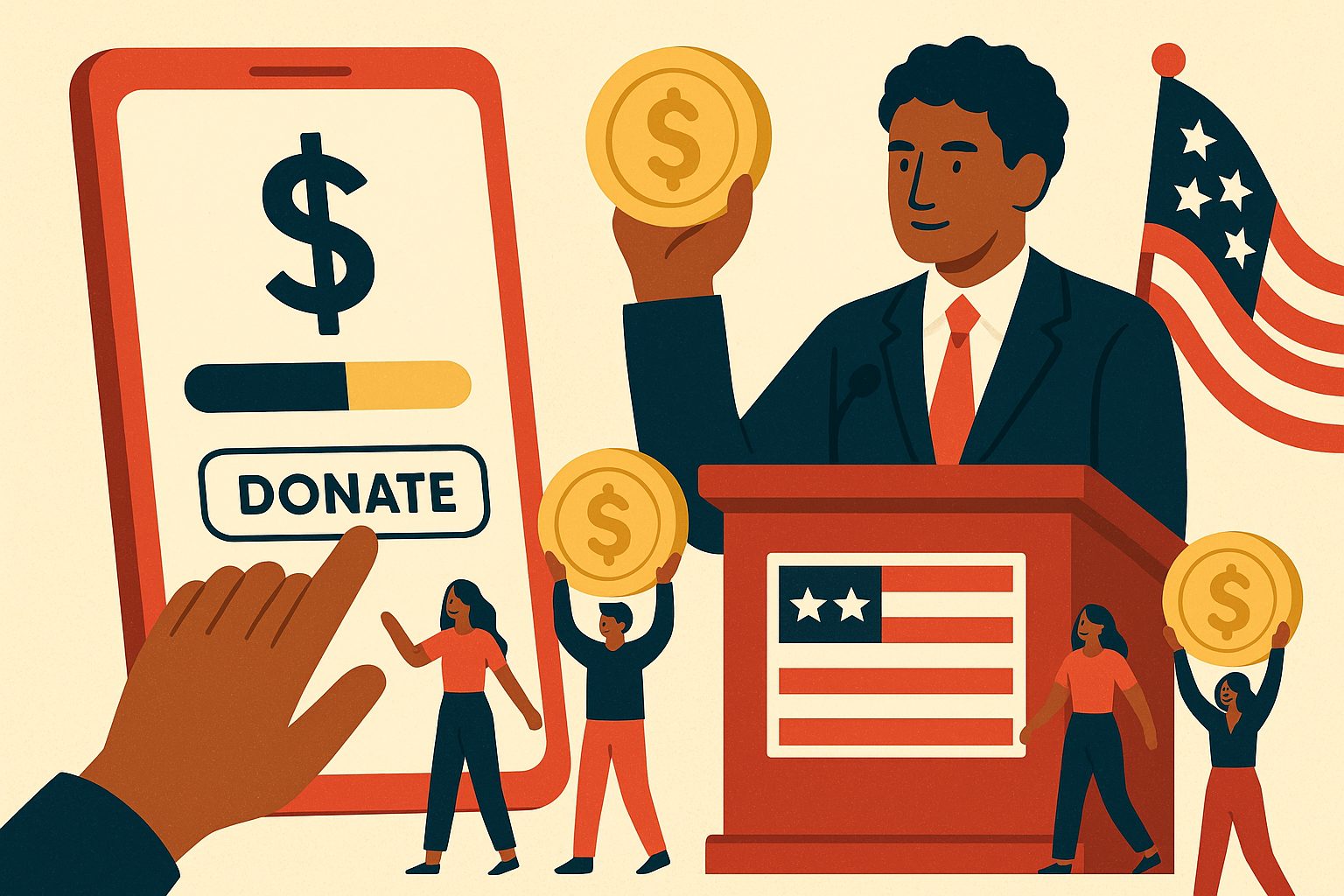Stepping into the Political Arena with Public Support
Launching a political campaign is a bold decision. Whether you’re running for city council, state legislature, or a seat in Congress, the moment you declare your candidacy, you step into a space that demands resilience, vision, and resources. For many first-time candidates, especially those without deep-pocketed donors or establishment ties, the biggest obstacle is funding. The cost of signage, digital ads, campaign staff, travel, and voter outreach adds up fast. But the good news is, there’s a powerful tool available that’s leveling the playing field—crowdfunding. Crowdfunding your political campaign allows you to bypass traditional fundraising roadblocks and connect directly with the people whose interests you aim to represent. It transforms your supporters into investors—not in your financial gain, but in your mission, your message, and your movement. For grassroots candidates, especially those running on platforms of justice, equity, or reform, crowdfunding isn’t just a funding strategy. It’s a declaration of independence from the status quo. In this guide, we’ll walk through how to use crowdfunding as the foundation of your political campaign’s financial engine—from planning and platforms to messaging and momentum.
Why Crowdfunding Works in Modern Politics
The digital age has redefined how we engage with politics. No longer are campaigns dependent solely on big donors, PACs, or local fundraising events. Platforms like ActBlue, GoFundMe, and Givebutter have enabled candidates at every level to harness small-dollar donations from thousands of supporters across the country. This democratization of campaign finance allows new voices to emerge and movements to build from the ground up. Crowdfunding works because it aligns with how people want to support candidates today—authentically, directly, and transparently. Supporters want to feel like they are part of a campaign, not just observers. When someone donates $10 to your campaign online, they’re not only giving money—they’re giving belief. Every donation, no matter the size, represents trust in your leadership and vision. It’s this sense of ownership that powers some of the most dynamic and engaging campaigns in recent memory. Crowdfunding also sends a message to the media and political observers that your campaign has momentum, grassroots support, and real-world relevance. It’s no longer about the size of the checks—it’s about the size of your coalition.
Finding the Right Crowdfunding Platform for Your Race
Choosing the right platform is one of the most strategic decisions you’ll make. Each platform comes with its own features, policies, and strengths. ActBlue is the most popular platform for Democratic and progressive candidates, offering powerful tools for fundraising, email integration, and donor analytics. For Republican candidates, WinRed provides similar functionality with a focus on conservative campaigns. If your race is nonpartisan or outside of party infrastructure, platforms like Givebutter or FundRazr may offer more flexibility and community engagement tools. The ideal platform for your campaign will depend on your audience, digital experience, and campaign goals. Some platforms offer customizable donation pages, mobile optimization, live event integration, and peer-to-peer fundraising options. Others focus more on simplicity and quick deployment. What matters most is that your platform is easy to use, trustworthy, and tailored to help you scale. Remember, donors judge the professionalism of a campaign not just by the candidate’s message but by how intuitive and secure their donation experience feels.
Telling Your Story to Spark Contributions
At the heart of every successful crowdfunding campaign is a compelling story. Your platform, policies, and plans are important, but people donate to people. They want to know who you are, what drives you, and why you’re the right person to fight for their future. Sharing your story isn’t just about resume highlights or political ideology—it’s about authenticity. Talk about the lived experiences that shaped your values. Be honest about the challenges you’ve faced. Let your vulnerability be part of your strength. Storytelling on your campaign page should feel like a conversation, not a press release. Supporters need to hear your voice, feel your passion, and understand your “why.” Great stories don’t just inform—they inspire. Once people are emotionally connected to your campaign, they’ll be far more likely to contribute and share your message with others.
Building Early Momentum from Day One
The first 72 hours of your crowdfunding campaign are critical. This is when initial energy builds, the platform’s algorithms may boost visibility, and your most loyal supporters are ready to take action. Don’t launch quietly. Build up to your launch with teaser posts, soft announcements, and direct outreach to your network. Reach out to family, friends, and local allies ahead of time, and ask them to donate as soon as the campaign goes live. Their early support sets the tone and helps build credibility. Donors are more likely to contribute to a campaign that already has visible traction. Create a launch day plan that includes social media announcements, email blasts, live video intros, and follow-up posts throughout the day. The more people see activity, energy, and urgency, the more inclined they’ll be to jump in and join.
Leveraging Social Media to Expand Reach
Crowdfunding and social media go hand in hand. If you want your campaign to reach beyond your immediate network, you need to master digital outreach. Use Instagram, Twitter, Facebook, and TikTok to tell your story, highlight milestones, and bring followers behind the scenes. Share video messages, testimonials, and campaign trail updates that keep your audience engaged. Hashtags and trends can help your campaign gain visibility, but nothing beats genuine connection. Respond to comments, tag donors (with permission), and build a two-way relationship with your followers. The more active and interactive you are, the more likely your posts will be shared and discovered. Visual content performs best, so don’t be afraid to get in front of the camera and speak directly to your audience. Crowdfunding isn’t just about asking for money—it’s about creating a digital movement that invites participation.
Turning Donors into Long-Term Supporters
The beauty of crowdfunding is that it builds more than just a budget—it builds a base. Every donor is a potential volunteer, advocate, or recurring contributor. Treat every donation as the beginning of a relationship, not the end. Follow up with thank-you messages, progress updates, and opportunities to get more involved. Transparency is key. Let supporters know how their money is being used and what kind of impact their contributions are making. Celebrate milestones, acknowledge major donors, and keep the energy flowing through regular communications. Email newsletters, social posts, and behind-the-scenes glimpses all help reinforce the connection. As supporters feel more included, they become more invested—not only financially, but emotionally and socially. The most successful crowdfunding campaigns are those that turn casual donors into campaign ambassadors who bring others along for the ride.
Using Campaign Milestones to Drive Excitement
Momentum matters in political crowdfunding, and one of the best ways to maintain it is through milestone goals. Instead of aiming for one large, distant number, break your fundraising journey into smaller, attainable goals. Announce when you’re halfway to funding your first mailer or have just enough for your first ad buy. These mini-milestones give your audience a sense of progress and help prevent donor fatigue. Celebrate these benchmarks publicly and use them as moments to renew urgency. Remind your audience that you’re not just raising money—you’re building a campaign, step by step. When people can see the finish line and understand exactly what their dollars are making possible, they’re far more likely to contribute again or help spread the word.
Preparing for the Mid-Campaign Plateau
Every crowdfunding campaign experiences a mid-cycle dip. After the initial wave of excitement, donations often slow down. But this is not the time to panic—it’s the time to plan. Prepare for the plateau by scheduling new content in advance. Share fresh videos, introduce endorsements, or highlight a new policy proposal. Inject novelty into your feed to re-engage your audience. Consider organizing a 24-hour push or matching donation challenge to reignite enthusiasm. Email your donor list with updates and specific asks, and remind them that you’re still counting on their continued support. This mid-campaign phase is also a great time to reach out to media outlets, community influencers, and allied organizations for features or shout-outs. Sustained visibility helps maintain credibility, while consistent outreach helps bring in new waves of support.
Closing Strong and Building for What Comes Next
The final stretch of your crowdfunding campaign is just as important as the beginning. Use the last 7 to 10 days to ramp up urgency. Let supporters know exactly how much you have left to raise and what’s at stake. Share countdown graphics, host live updates, and emphasize how every single donation counts in the final push. As you approach your goal, don’t slow down—speed up. Finish with the same fire you started with. When your campaign ends, your communication shouldn’t. Thank every donor personally when possible, and post a public message of gratitude. Let your audience know what comes next. Are you filing for the ballot? Printing yard signs? Hosting town halls? Keep them engaged and give them reasons to stick around. The energy you create during your crowdfunding campaign becomes the foundation for your broader campaign infrastructure. Use it to launch forward with confidence, credibility, and a growing team of people who believe in what you stand for.




